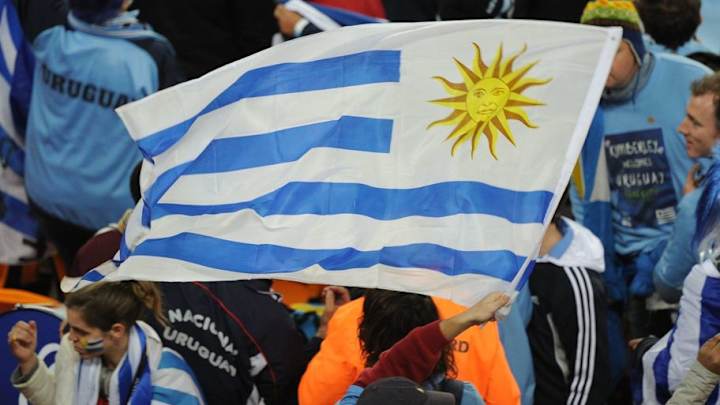World Cup Countdown: 20 Weeks to Go - 'Victory or Death!' Argentina & Uruguay's Classic Final

“Argentina yes! Uruguay no! Victory or death!"
The first ever World Cup final set a standard for hostility and hatred which has remained unrivalled in the 88 years since. The world demanded it, the police dreaded it, but as the tournament wore on it became apparent that two teams stood head and shoulders above the rest.
They were the hosts and favourites Uruguay, and their arch-rivals Argentina. Some details of the game have faded over time, but history remembers a ferocious, entertaining match which set a standard that World Cups have been trying to live up to ever since.
The good old days! pic.twitter.com/TropW1IR3h
— La Celeste Blog (@lacelesteblog) January 21, 2018
(You may also be interested in World Cup Countdown: 20 Weeks to Go - Where it All Started, The Story of Uruguay's 1930 Victory)
The first World Cup may seem like the dawn of international football, but Uruguay and Argentina had already been battling it out for continental supremacy for years by that point. Ten of the first twelve South American Championships (now the Copa America) had been won by either La Celeste or their neighbours, with only Brazil’s first two titles preventing complete domination.
Uruguay had also won the football gold medal at the 1924 and 1928 Olympic games, beating Argentina in the latter final. In the eyes of the global public, the World Cup final would be the culmination of years of rivalry, the ultimate game to decide which of these two era-defining teams was the greater.
All Uruguay and Argentina had to do was make sure they got to the final, and both did it with a minimum of fuss. 100% records in the group stages were followed by 6-1 semi-final wins – a margin of victory which would remain the semi-final record until Germany devastated Brazil 84 years later.
To say that tensions were high in the build-up to the game is an understatement. The police presence in Montevideo was heightened beyond anything in living memory. A convoy of boats laden with Argentina supporters left Buenos Aires to the tune of that incessant and sinister demand – “victory or death!” At the stadium, all fans were searched for guns or other weaponry.
The brave man in control of the game was Belgium’s John Langenus, who travelled over to South America on a boat which also contained four of the competing squads. In something reminiscent of a Fast Show sketch, Langenus officiated all his games in a full suit and tie. One of the linesmen for the final was Romania manager Costel Rădulescu, who clearly wanted to get the most out of his holiday.
NOSTALJİ |
— ali erim (@alierim) December 1, 2017
1930 Dünya Kupası Finali öncesi hakem John Langenus
John Langenus holding the match ball before the final of the 1930 World Cup
#WorldCupDraw pic.twitter.com/RnDJ18J3c2
The two teams couldn’t agree on a match ball, so came to the compromise that the first half would be played with Argentina’s choice, and the second half with Uruguay’s. And finally, the first World Cup final was ready to get underway, with most in the Estadio Centenario anticipating a Uruguay win. The host nation took the lead after just twelve minutes through Pablo Dorado, but Argentina struck back shortly after through Carlos Peucelle.
This is where the details start to get murky. Guillermo Stabile scored in the 37th minute to give Argentina a 2-1 lead…possibly. Well, someone definitely scored for the visitors, but the scorer and time of the goal are heavily disputed by football historians. FIFA says it was Stabile however, so we’ll go with that. At half-time, Argentina’s match ball was clearly working wonders, and the home crowd were in mutinous shock.
Uruguay emerged for the second half, and so did their match ball. By the hour mark, they were level, although again the timing and scorer are disputed – FIFA gave it to Pedro Cea. Ten minutes later, Santos Iriarte put Uruguay ahead, and with Argentina reduced to ten men through injury, their race was run. Héctor Castro added some gloss to the scoreline before the end with a fourth goal. It was the pinnacle of a career made even more remarkable by the fact that Castro had only one arm, having lost his right to an electric saw as a child.
At full-time the pitch was flooded with jubilant Uruguayans, and Langenus saw his chance to escape, fleeing the field and heading for the harbour. As José Nasazzi became the first man to lift aloft the Jules Rimet trophy, Langenus was stowing away on a boat back to Europe. He managed to avoid reprisals, but others were not so lucky. Riots broke out in Buenos Aires, and a large group of disgruntled demonstrators threw stones at the Uruguayan consulate. The Argentinean Football Association protested that many of their players had returned home with wounds sustained during the final, but the major hurts inflicted were not the physical ones.
“I still remember it so well and it makes me so angry,” remembered Argentina’s Francisco Varallo, who had to leave the pitch injured at 2-1. “I still wonder how we let it slip, and I am convinced that if I had stayed on the pitch we would have won. In my whole life I've never felt such a bitter pain as losing that final."
Varallo died in 2010 at the age of 100, the last surviving finalist. But the legacy of that first final lives on, and few finals in the modern era have come close to matching it for entertainment.
